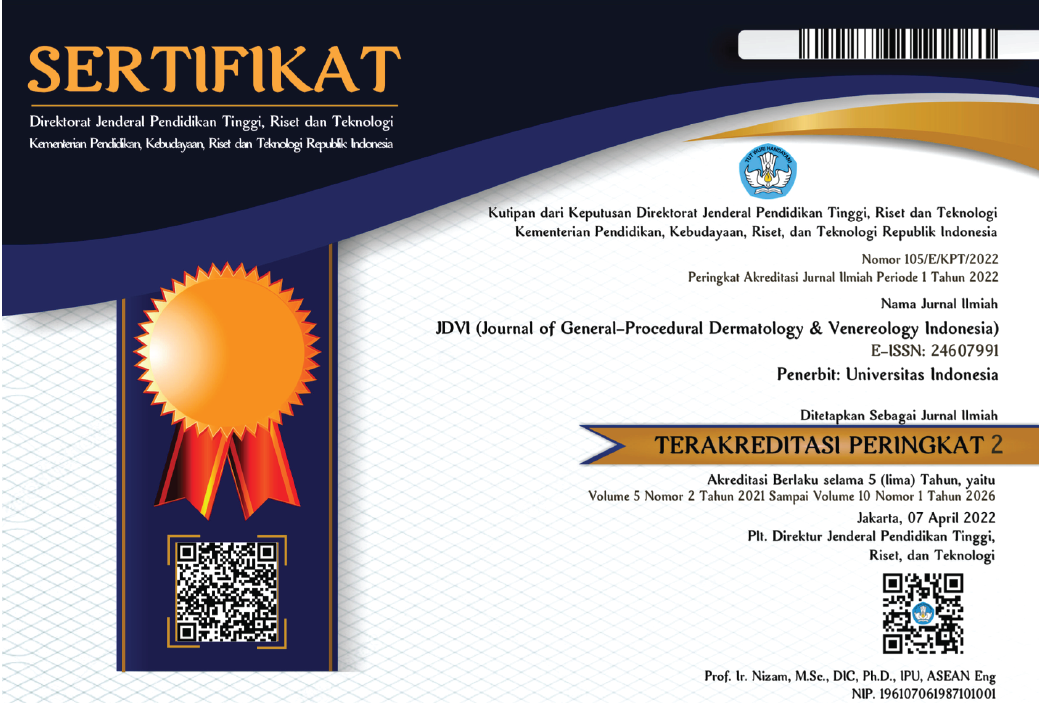Abstract
Background: Wounds that fail to proceed through the normal healing process are referred to as chronic wounds, also known as ulcers. Chronic wounds have immeasurable biological, psychological, social, and economic effects, bringing tremendous challenges for patients, doctors, healthcare providers, and healthcare systems.
Discussion: This condition is associated with a variety of comorbidities and complex etiologies. The global incidence of chronic wounds is expected to increase with longer life expectancy. Thus, a holistic approach is necessary, such as proper wound management, proper control of comorbidities, and provision of adequate nutrition, including vitamin D supplementation. Vitamin D is an essential pro-hormone for cell differentiation, proliferation, and growth. It affects the skin’s immune response, and is therefore thought to promote wound healing and tissue repair. Many studies have been published on the association between low vitamin D levels and chronic wounds. However, whether or not vitamin D supplementation directly contributes to wound healing still needs to be elucidated.
Conclusion: Despite the many reports on vitamin D as an adjuvant treatment for chronic wounds, further large-scale clinical studies are needed to cement the role of vitamin D as an effective standard therapy for chronic wound healing.
References
- Frykberg RG, Banks J. Challenges in the treatment of chronic wounds. Adv Wound Care (New Rochelle). 2015;4(9):560-82.
- Järbrink K, Ni G, Sönnergren H, et al. Prevalence and incidence of chronic wounds and related complications: A protocol for a systematic review. Syst Rev. 2016;5(1):152.
- Hjort A, Gottrup F. Cost of wound treatment to increase significantly in Denmark over the next
decade. J Wound Care. 2010;19(5):173-4. - Pant J, Goudie MJ, Brisbois EJ, Handa H. 14- nitric oxide-releasing polyurethanes. In: Cooper SL, Guan J, editors. Advances in polyurethane biomaterials. Woodhead Publishing; 2016. p. 417-49.
- Collier M. Recognition and management of wound infections [Internet]. World Wide Wounds; 2004. [reviewed 2004 Oct 18; cited 2024 Jun 23] Available from: http://www.worldwidewounds.com/2004/january/Collier/Management-of-Wound infections.html
- Gupta S, Andersen C, Black J, et al. Management of chronic wounds: Diagnosis, preparation, treatment, and follow-up. Wounds. 2017;29(9):S19-36.
- Smith K, Hewlings S. Correlation between vitamin D levels and hard-to-heal wounds: A systematic review. J Wound Care. 2020;29(Suppl7):S24-30.
- Mostafa WZ, Hegazy RA. Vitamin D and the skin: Focus on a complex relationship: A review. J Adv Res. 2015;6(6):793-804.
- Sibbald GR, Woo KY. The biology of chronic foot ulcers in persons with diabetes. Diabetes Metab Res Rev. 2008;24(Suppl 1):S25-30.
- Kyaw BM, Järbrink K, Martinengo L, Car J, Harding K, Schmidtchen A. Need for improved definition of "chronic wounds" in clinical studies. Acta Derm Venereol. 2018;98(1):157-8.
- Olsson M, Järbrink K, Divakar U, et al. The humanistic and economic burden of chronic wounds: A systematic review. Wound Repair Regen. 2019;27(1):114-25.
- Martinengo L, Olsson M, Bajpai R, et al. Prevalence of chronic wounds in the general population: Systematic review and meta-analysis of observational studies. Ann Epidemiol. 2019;29:8-15.
- Wocare Inti Nusantara. Perawatan luka bagi praktisi kesehatan di fasilitas pelayanan kesehatan. Wocare Center; 2019. Indonesian.
- Probst S, Weller CD, Bobbink P, et al. Prevalence and incidence of venous leg ulcers-a protocol for a systematic review. Syst Rev. 2021;10(1):148.
- Borojeny LA, Albatineh AN, Dehkordi AH, Gheshlagh RG. The incidence of pressure ulcers and its associations in different wards of the hospital: A systematic review and meta-analysis. Int J Prev Med. 2020;11:171.
- Zhang P, Lu J, Jing Y, Tang S, Zhu D, Bi Y. Global epidemiology of diabetic foot ulceration: A systematic review and meta-analysis. Ann Med. 2017;49(2):106-16.
- Kemenkes RI. Situasi dan analisis diabetes. In: Kemenkes, editor. Jakarta: Pusat Data dan Informasi Kementerian Kesehatan Republik Indonesia; 2014. Indonesian.
- Vanchinathan V, Lim HW. A dermatologist's perspective on vitamin D. Mayo Clin Proc. 2012;87(4):372-80.
- Zittermann A, Frisch S, Berthold HK, et al. Vitamin D supplementation enhances the beneficial effects of weight loss on cardiovascular disease risk markers. Am J Clin Nutr. 2009;89(5):1321-7.
- Boulton AJ, Vileikyte L, Ragnarson-Tennvall G, Apelqvist J. The global burden of diabetic foot disease. Lancet. 2005;366(9498):1719-24.
- Zhang JZ, Maruyama K, Ono I, Kaneko F. Production and secretion of platelet-derived growth factor AB by cultured human keratinocytes: Regulatory effects of phorbol 12-myristate 13-acetate, etretinate, 1,25-dihydroxyvitamin D3, and several cytokines. J Dermatol. 1995;22(5):305-9.
- Balasubramanian S, Eckert RL. Keratinocyte proliferation, differentiation, and apoptosis--differential mechanisms of regulation by curcumin, EGCG and apigenin. Toxicol Appl Pharmacol. 2007;224(3):214-9.
- Mozaffari-Khosravi H, Haratian-Arab M, MoeinTavakkoli H, Nadjarzadeh A. Comparative effect of two different doses of vitamin D on diabetic foot ulcer and inflammatory indices among the type 2 diabetic patients: A randomized clinical trial. Iranian Journal of Diabetes and Obesity. 2016;8(4):164-171.
- Schauber J, Dorschner RA, Coda AB, et al. Injury enhances TLR2 function and antimicrobial peptide expression through a vitamin D-dependent mechanism. J Clin Invest. 2007;117(3):803-11.
- Wang TT, Nestel FP, Bourdeau V, et al. Cutting edge: 1,25-dihydroxyvitamin D3 is a direct inducer of antimicrobial peptide gene expression. J Immunol. 2004;173(5):2909-12.
- Gombart AF, Borregaard N, Koeffler HP. Human cathelicidin antimicrobial peptide (CAMP) gene is a direct target of the vitamin D receptor and is strongly up-regulated in myeloid cells by 1,25-dihydroxyvitamin D3. FASEB J. 2005;19(9):1067-77.
- Heilborn JD, Nilsson MF, Kratz G, et al. The cathelicidin anti-microbial peptide LL-37 is involved in re-epithelialization of human skin wounds and is lacking in chronic ulcer epithelium. J Invest Dermatol. 2003;120(3):379-89.
- Koczulla R, von Degenfeld G, Kupatt C, et al. An angiogenic role for the human peptide antibiotic LL-37/hCAP-18. J Clin Invest. 2003;111(11):1665-72.
- Weber G, Heilborn JD, Jimenez CIC, Hammarsjo A, Törmä H, Stahle M. Vitamin D induces the antimicrobial protein hCAP18 in human skin. J Invest Dermatol. 2005;124(5):1080-2.
- Dixon BM, Barker T, McKinnon T, et al. Positive correlation between circulating cathelicidin antimicrobial peptide (hCAP18/LL-37) and 25-hydroxyvitamin D levels in healthy adults. BMC Res Notes. 2012;5:575.
- Duplantier AJ, van Hoek ML. The human cathelicidin antimicrobial peptide ll-37 as a potential treatment for polymicrobial infected wounds. Front Immunol. 2013;4:143.
- Jacobsen AS, Jenssen H. Human cathelicidin LL-37 prevents bacterial biofilm formation. Future Med Chem. 2012;4(12):1587-99.
- Holick MF. Vitamin D deficiency. N Engl J Med. 2007;357(3):266-81.
- Krejner A, Litwiniuk M, Grzela T. LL-37 but not 25-Hydroxy-Vitamin D serum level correlates with healing of venous leg ulcers. Arch Immunol Ther Exp (Warsz). 2017;65(5):455-61.
- Burkievcz CJC, Skare TL, Malafaia O, Nassif PAN, Ribas CSG, Santos LRP. Vitamin D deficiency in patients with chronic venous ulcers. Rev Col Bras Cir. 2012;39(1):60-3.
- Burkiewicz CJCC, Guadagnin FA, Skare TL, do Nascimento MM, Servin SC, de Souza GD. Vitamin D and skin repair: A prospective, double-blind and placebo controlled study in the healing of leg ulcers. Rev Col Bras Cir. 2012;39(5):401-7.
- Otero TMN, Canales C, Yeh DD, Elsayes A, Belcher DM, Quraishi SA. Vitamin D status is associated with development of hospital-acquired pressure injuries in critically Ill surgical patients. Nutr Clin Pract. 2019;34(1):142-7.
- Lussi C, Frotzler A, Jenny A, Schaefer DJ, Kressig RW, Scheel-Sailer A. Nutritional blood parameters and nutritional risk screening in patients with spinal cord injury and deep pressure ulcer-a retrospective chart analysis. Spinal Cord. 2018;56(2):168-75.
- Abdulwadood MZ, Ali SH. Study of vitamin D
level in relation to pressure ulcer in elderly.
International Journal of Recent Scientific Research. 2016;7(2):8970-3. - Zubair M, Malik A, Meerza D, Ahmad J. 25-hydroxyvitamin D [25(OH)D] levels and diabetic foot ulcer: Is there any relationship?. Diabetes Metab Syndr. 2013;7(3):148-53.
- Tiwari S, Pratyush DD, Gupta B, et al. Prevalence and severity of vitamin D deficiency in patients with diabetic foot infection. Br J Nutr. 2013;109(1):99-102.
- Razzaghi R, Pourbagheri H, Momen-Heravi M, et al. The effects of vitamin D supplementation on wound healing and metabolic status in patients with diabetic foot ulcer: A randomized, double-blind, placebo-controlled trial. J Diabetes Complications. 2017;31(4):766-72.
- Gonzalez-Curiel I, Trujillo V, Montoya-Rosales A, et al. 1,25-dihydroxyvitamin D3 induces LL-37 and HBD-2 production in keratinocytes from diabetic foot ulcers promoting wound healing: An in vitro model. PLoS One. 2014;9(10):e111355.
- Çağlar S, Çağlar A, Pilten S, Albay C, Beytemur O, Sarı H. Osteoprotegerin and 25-hydroxy vitamin D levels in patients with diabetic foot. Eklem Hastalik Cerrahisi. 2018;29(3):170-5.
- Feldkamp J, Jungheim K, Schott M, Jacobs B, Roden M. Severe vitamin D3 deficiency in the majority of patients with diabetic foot ulcers. Horm Metab Res. 2018;50(8):615-9.
- Najafipour F, Aghamohammadza N, Zonouz NR, Houshyar J. Role of serum vitamin D level in progression of diabetic foot ulcer. Journal of Clinical and Diagnostic Research. 2019;13(2):BC15-7.
- Al-Shamma K, Muslim S, Abdulrahman N. Study the effect of zinc/or vit.D3 on percentage of healing of diabetic foot ulcer in Iraqi patients. IJAPBC. 2013;2(4):600-4.
- Holick MF, Binkley NC, Bischoff-Ferrari HA, et al. Evaluation, treatment, and prevention of vitamin D deficiency: An Endocrine Society clinical practice guideline. J Clin Endocrinol Metab. 2011;96(7):1911-30.
Recommended Citation
Priyanto, Mufqi Handaru; Miranda, Eliza; Yusharyahya, Shannaz Nadia; Legiawati, Lili; Novianto, Endi; Bramono, Kusmarinah; and Krisanti, Roro Inge Ade
(2024)
"The effects of vitamin D on chronic wounds,"
Journal of General - Procedural Dermatology and Venereology Indonesia: Vol. 8:
Iss.
1, Article 9.
DOI: 10.7454/jdvi.v8i1.1133
Available at:
https://scholarhub.ui.ac.id/jdvi/vol8/iss1/9
Included in
Dermatology Commons, Integumentary System Commons, Skin and Connective Tissue Diseases Commons






























